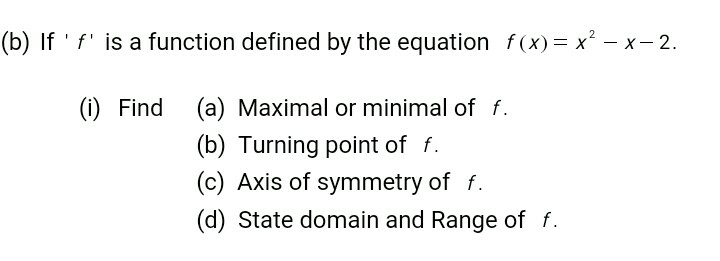
Question Number 74138 by MASANJAJ last updated on 19/Nov/19

Commented by mathmax by abdo last updated on 19/Nov/19
![f(x)=x^2 −x−2 =x^2 −2(1/2)x +(1/4) −(1/4)−2 =(x−(1/2))^2 −(9/4) ⇒minf(x)=−(9/4) and no maximum i supoose that the turning point is fixed point ⇒f(x)=x ⇒ x^2 −x−2=x ⇒x^2 −2x−2=0 →Δ^′ =1+2=3 ⇒x_1 =1+(√3) and x_2 =1−(√3) the axis of symetrie is the line x=(1/2) f is defined on R and the varistion of is x −∞ (1/2) +∞ f^′ (x) − 0 + f(x) +∞ decr −(9/4) incr +∞ ⇒f(]−∞ ,(1/2)] =[−(9/4),+∞[ and f[(1/2),+∞[) =[−(9/4),+∞[](Q74157.png)
$${f}\left({x}\right)={x}^{\mathrm{2}} −{x}−\mathrm{2}\:={x}^{\mathrm{2}} −\mathrm{2}\frac{\mathrm{1}}{\mathrm{2}}{x}\:+\frac{\mathrm{1}}{\mathrm{4}}\:−\frac{\mathrm{1}}{\mathrm{4}}−\mathrm{2}\:=\left({x}−\frac{\mathrm{1}}{\mathrm{2}}\right)^{\mathrm{2}} −\frac{\mathrm{9}}{\mathrm{4}} \\ $$$$\Rightarrow{minf}\left({x}\right)=−\frac{\mathrm{9}}{\mathrm{4}}\:\:\:\:{and}\:{no}\:{maximum} \\ $$$${i}\:{supoose}\:{that}\:{the}\:{turning}\:{point}\:{is}\:{fixed}\:{point}\:\Rightarrow{f}\left({x}\right)={x}\:\Rightarrow \\ $$$${x}^{\mathrm{2}} −{x}−\mathrm{2}={x}\:\Rightarrow{x}^{\mathrm{2}} −\mathrm{2}{x}−\mathrm{2}=\mathrm{0}\:\rightarrow\Delta^{'} =\mathrm{1}+\mathrm{2}=\mathrm{3}\:\Rightarrow{x}_{\mathrm{1}} =\mathrm{1}+\sqrt{\mathrm{3}} \\ $$$${and}\:{x}_{\mathrm{2}} =\mathrm{1}−\sqrt{\mathrm{3}} \\ $$$${the}\:{axis}\:{of}\:{symetrie}\:{is}\:{the}\:{line}\:{x}=\frac{\mathrm{1}}{\mathrm{2}} \\ $$$${f}\:{is}\:{defined}\:{on}\:{R}\:\:{and}\:{the}\:{varistion}\:{of}\:{is} \\ $$$${x}\:\:\:\:\:\:\:\:\:\:−\infty\:\:\:\:\:\:\:\:\:\:\:\:\:\:\:\:\:\:\:\:\frac{\mathrm{1}}{\mathrm{2}}\:\:\:\:\:\:\:\:\:\:\:\:\:\:\:+\infty \\ $$$${f}^{'} \left({x}\right)\:\:\:\:\:\:\:\:\:\:\:\:\:\:\:\:\:\:\:\:−\:\:\:\:\:\:\:\:\mathrm{0}\:\:\:\:\:\:\:\:\:\:+ \\ $$$${f}\left({x}\right)\:\:\:\:\:+\infty\:\:\:\:{decr}\:\:−\frac{\mathrm{9}}{\mathrm{4}}\:\:\:\:{incr}\:\:+\infty \\ $$$$\left.\Rightarrow{f}\left(\right]−\infty\:,\frac{\mathrm{1}}{\mathrm{2}}\right]\:=\left[−\frac{\mathrm{9}}{\mathrm{4}},+\infty\left[\:\:\:{and}\:\:{f}\left[\frac{\mathrm{1}}{\mathrm{2}},+\infty\left[\right)\:=\left[−\frac{\mathrm{9}}{\mathrm{4}},+\infty\left[\right.\right.\right.\right.\right. \\ $$
Commented by MJS last updated on 20/Nov/19

$$\mathrm{turning}\:\mathrm{point}\:=\:\mathrm{inflection}\:\mathrm{point}? \\ $$$${f}''\left({x}\right)=\mathrm{0} \\ $$$${f}''\left({x}\right)=\mathrm{2}\:\neq\mathrm{0}\:\Rightarrow\:\mathrm{no}\:\mathrm{turning}\:\mathrm{point} \\ $$
